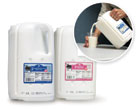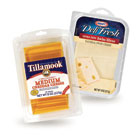
Driven by sustainability, energy costs and other imperatives, dairy packaging is undergoing a shake-up.
Are we about to see the parting of the White Sea?
Dairy foods like milk, cheese and yogurt have been, up to now, some of the most commoditized products in the grocery store. This has led to homogeneous packaging that made the dairy aisle a “sea of white.” But new developments, in processing techniques, marketing imperatives and other aspects, are leading to a sea change in the way milk and other dairy products are packaged.
As with most other foods, sustainability is a major packaging imperative for dairy products. This has led to some rethinking of the most basic types of dairy packaging.
“U.S. dairy leaders are coming together and have launched a comprehensive sustainability initiative that will encourage industry innovation, improve environmental performance and really position the industry in the best possible way for future marketplace demands,” says Gail Barnes, vice president for technology and packaging at Dairy Management Inc.

Pouring accurately from Sam's Club's new square milk jug takes a little getting used to. The trick is to keep it on the table.
Square jugs
One of the most interesting developments in sustainable dairy packaging got a big boost when it was recently picked up by the Sam’s Club division of Wal-Mart: the square milk jug. Developed early last year by a dairy in Canton, Ohio, the square 1-gallon jug features a pour spout in a recessed corner, configured so that the top of the closure is flush with the rest of the jug’s top surface.The result is a jug that can be stacked up to six high on a pallet, without the use of milk crates or any secondary packaging other than slip sheets. Getting rid of the crates means not having to wash them, handle them, ship them or guard them against theft.
There’s another important environmental advantage to the square jug, says Wal-Mart spokesperson Kristy Reed. It allows about 400 more gallons, or an additional 9%, to be loaded per truck; in conjunction with other efficiencies, this will eliminate 11,000 truckloads annually.
Consumers share in the cost savings, too, as Wal-Mart promotes on its website: “At a time when the impact of food inflation appears on every grocery receipt, the new case-less jug also delivers a cost savings of 10 to 20 cents.”
The square jug is available at Sam’s Clubs in Alabama, Arkansas, Florida, Georgia, Kentucky, Michigan, Nevada, Ohio, South Carolina and Tennessee. Four dairies nationwide supply the package, which requires a special filler and extended shelf life (ESL) pasteurizer. The filler does not contact the spout during filling, which adds to sterility (and, therefore, shelf life) for both package and machine.
The new jug takes some getting used to on the part of consumers. It’s sometimes referred to as a “rock-and-pour,” because the trick is to keep it on the table or counter and tip it forward to direct the flow into a glass (at least, until the jug starts to empty). Consumers who try to lift it and pour, as they do with conventional jugs, probably will miss their target. On the food blog slashfood.com, comments were almost evenly divided for (“I like that it fits in the door of the fridge a lot. I like that the weight is more evenly distributed, too. The round jugs were hard on my wrists”) and against (“These things are horrible to drink out of. I end up getting milk all down my chin and on my shirt”).
According to Mona Doyle, chief executive officer of The Consumer Network, consumers may learn to accept the new package, in spite of its differences.
“In these difficult times, getting milk for less is almost as appealing as getting gas for less,” Doyle says. “As long as the retailers tell their customers why the new packages are important, most customers will accept them.”
Another possibly significant advance on milk-container sustainability is taking place across the Atlantic. Sainsbury’s, the British supermarket chain, recently introduced a system that combines milk in flexible plastic bags with specially designed rigid plastic jugs and spouts, purchased and reused by the consumer.
The Jugit system uses pouches with two-pint capacity, in conjunction with a pitcher with a removable top. Consumers place the bag in the pitcher and, when they put the top in place, a spike pierces the pouch, starting the flow of milk and guarding against leaks. Sainsbury’s estimates that the Jugit system will cut packaging waste by up to 75%.
Aseptic obstacles
One processing/packaging option for milk that has never really caught on in the United States, at least to the extent that it has in Europe, is aseptic. There are two challenges to aseptic milk in the U.S.: American consumers have been conditioned to think of milk as something that needs to be distributed and stored through a cold chain; and aseptic processing, because it uses higher temperatures than pasteurization, gives the milk a flavor that is different from pasteurized.But two factors may overcome those obstacles, Barnes says. High energy costs make the cold chain ever more expensive to maintain: “You’ve got retailers that are really looking to cut costs, turn off the chillers and move product into shelf-stable.” And new non-thermal processing technologies like ultraviolet treatment raise the possibility of aseptic milk without the cooked taste, although these are a ways from commercialization.
Traditionally, flavored dairy-based beverages have done better in aseptic form than white milk. Rigid packaging for such products is beginning to migrate from Europe, where it has long been accepted, to the U.S.
One twist on the rigid aseptic process was recently approved for the first time in the U.S. Gehl Foods, Germantown, Wis., a processor of low-acid aseptic products, recently got permission from the Food and Drug Administration for a rigid-bottle, low-acid filler that applies hydrogen peroxide to bottles with vapor deposition.
Hydrogen peroxide is a commonly used sterilant for aseptic processing, with laminated paperboard (such as Tetra Pak) as well as bottles. The new Gehl line, from KHS USA Inc., is unique in that it coats the bottles with hydrogen peroxide consistently without flooding them, meaning that there is no need to recover and reuse the leftover sterilant. This makes the lines simpler and more efficient, says KHS spokesperson Ron Kiesling.
Gehl will use the process for milk-based smoothies, coffee drinks and nutritional drinks, scheduled for rollout in October. The high-density polyethylene bottles will be Gehl’s first use of plastic containers; it has used steel cans exclusively.

Both Kraft Foods and Tillamook Cheese have moved some of their sliced cheeses into rigid trays. Kraft intends to phase out flexible packaging for this product.
Cheese trays
A couple of new cheese packages have one thing in common with the Gehl aseptic bottles: They use rigid packaging for something that has been better known in flexible film.Both Kraft Foods and Tillamook Cheese, Tillamook, Ore., are switching from flexible film to rigid gas-flushed trays for cheese slices. In Kraft’s case, the package is Kraft Deli Fresh, extra-thick shingled slices. Kraft changed the name from Deli Deluxe to better leverage the product with Oscar Mayer Deli Fresh cold cuts.
Tillamook Cheese came out with rigid eight-pack trays, also gas-flushed, for seven flavors of cheese early this year. The package comprises a polypropylene tray and polystyrene lid.
“In addition to convenience, the new rigid pack packaging also provides product display options,” says Jay Allison, Tillamook Cheese’s vice president of sales and marketing. “The new package can be sold in a display box, on a peg bar or even stacked in the case, possibly next to the ground beef.”
Recent developments show that dairy product packaging need not be as bland as white milk. By taking advantage of new trends and technologies, packaging can do its part to revitalize the category. F&BP
FOR MORE INFORMATION
KHS USA262-797-7200
